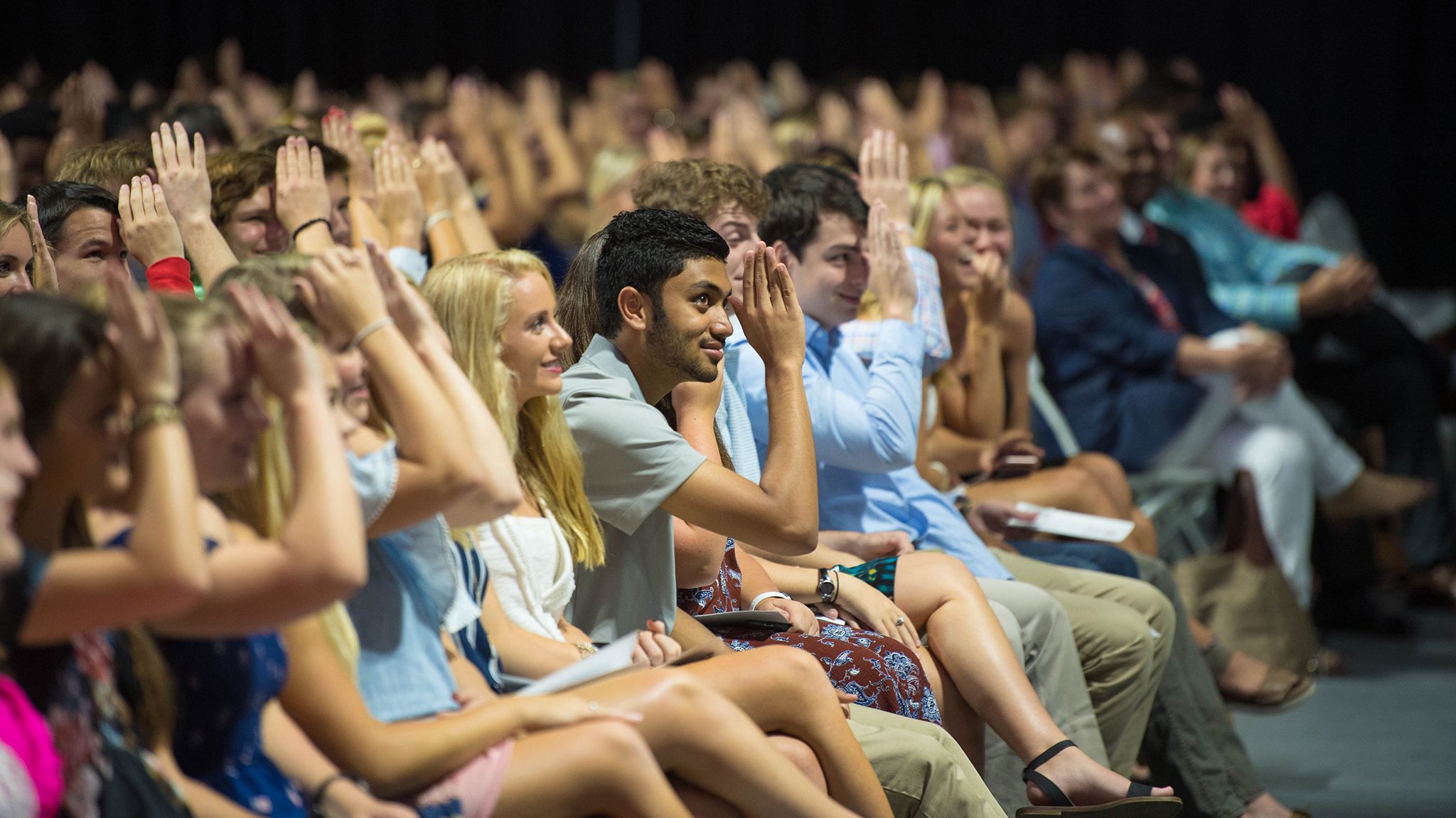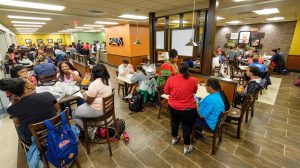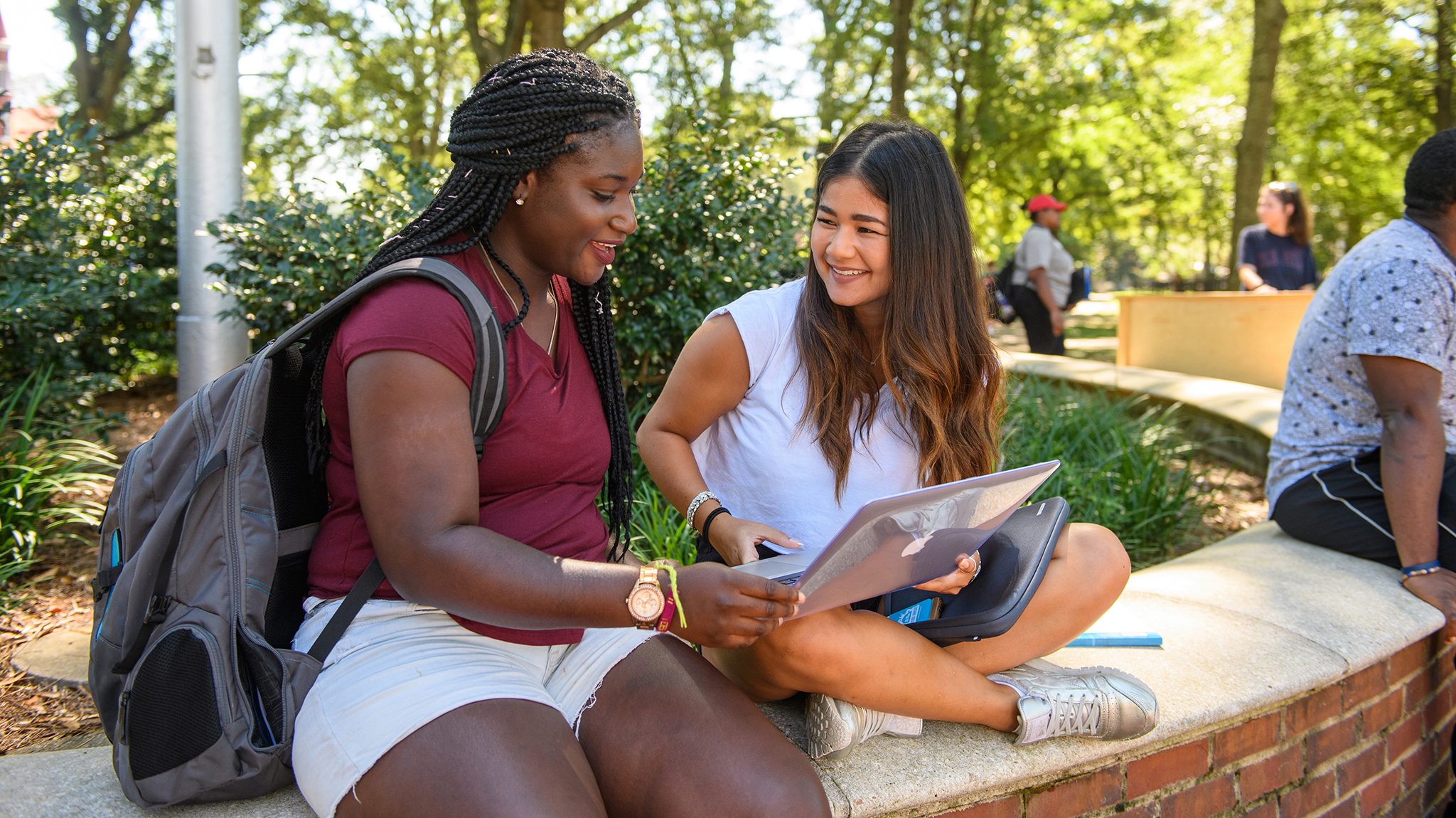
Freshmen throw up the Landshark sign during the University of Mississippi’s Fall Convocation. The university enrolled 3,697 freshmen this fall and 23,780 students overall. Photo by Kevin Bain/Ole Miss Communications
OXFORD, Miss. – The University of Mississippi has registered 23,780 students across all its campuses, the state’s largest total enrollment, for the fall semester. This includes a freshman class with a larger proportion of Mississippi residents than last year’s.
Enrollment at the state’s flagship university reflects a strategy aimed at balancing incoming classes to be more representative of its home state by concentrating recruiting efforts in-state and raising out-of-state academic requirements.
“We are so pleased to welcome our newest freshmen and transfer students who will contribute to our ever-increasing academic excellence, stellar learning environment and outstanding college experience,” Chancellor Jeffrey Vitter said. “As we remain committed to offering a flagship education, we will also continue to manage our growth with great care.”
This year’s freshman class of 3,697 students includes a greater percentage of Mississippi residents, 45.4 percent – a 2.5 percent increase over last year. It also has a higher percentage of minorities, 21.2 percent, than last year’s entering class.
Growth in both areas reflects a strategy aimed at aligning enrollment with the university’s core mission of educating Mississippians, said Brandi Hephner LaBanc, vice chancellor for student affairs.
“We have focused on recruiting more Mississippi students, through our general admissions programs, our MOST mentoring program and hosting important programs such as the American Legion’s Boys State,” she said. “It is rewarding to see growth in these areas through our concerted efforts.”
To help accommodate an Oxford campus population that has increased by 62 percent over the past decade, the university has been renovating buildings and constructing new facilities. The university has some $400 million worth of construction recently completed, in progress or on the drawing board.
In recent weeks, a new 1,500-space residential garage, the renovated Gillom Women’s Sports Center and the expanded Student Union food court opened, providing new options for students. The food court is part of an ongoing $59 million expansion and renovation project that will increase the Student Union’s size from 97,000 to 173,000 square feet by 2019.
The university also is working on a new recreation center and transportation hub, a $32 million project on the south end of campus; a $23.5 million renovation and expansion of Garland, Hedleston and Mayes halls, which will provide a new home for the School of Applied Sciences and new classrooms; and renovation of public spaces and offices in Johnson Commons East.
“In orientation sessions, we talk about the Ole Miss family,” Hephner LaBanc said. “If we’re going to keep that feel on campus, we have to manage our growth and make sure students can navigate our campus easily and have access to the academic and co-curricular spaces that make them feel comfortable calling this home.”
Incoming freshmen posted an average ACT score of 25.04. The class’ average high school GPA of 3.59, up from last year’s 3.57, is a university record.
This year’s first-time students include 85 class valedictorians, 69 salutatorians, 89 student body presidents, 107 Eagle Scouts and 20 Girl Scouts who achieved the Gold Award, the organization’s highest youth honor.

The expanded Ole Miss Student Union, which opened for the fall semester, features dining options including Chick-fil-A, Panda Express, Qdoba, Which Wich and McAlister’s Deli. Photo by Robert Jordan/Ole Miss Communications
The freshman class also includes 10 recipients of Stamps scholarships, among the largest and most prestigious at Ole Miss. The Stamps Family Charitable Foundation is a national scholarship program that selects recipients for the awards based on their strong leadership potential, academic merit and exceptional character.
UM is among only 33 universities nationally in the Stamps program, and one of only six institutions with at least 10 scholars.
“Our university has a long history of attracting and developing outstanding student leaders and scholars,” said Noel Wilkin, interim provost. “We offer them valuable educational experiences and help them recognize and hone their talents.
“I look forward to seeing what this talented group of freshmen can accomplish. I fully expect them to have a tremendous influence on our local and global communities during their time here and beyond.”
The university’s efforts to help new students adjust to college life and be successful – including FASTrack and the Freshman Year Experience program – also continue to pay dividends. Student retention remained near record levels, with 85.2 percent of last year’s freshmen returning to campus to continue their studies this fall.
Though the university receives an impressive number of nonresident applications, 12,399 for the fall semester alone, the majority of Ole Miss students, 60.2 percent, are from Mississippi, including students from all the state’s 82 counties.
The university also attracts students from around the nation and world. Overall, the student body includes representatives from every state and 86 foreign countries.
Minority enrollment totaled 5,526 students, or 23.2 percent. African-American enrollment is 3,011 students, or 12.7 percent of overall enrollment.
With an expanded building, the Sally McDonnell Barksdale Honors College grew to 1,512 total students this fall, compared to 667 students just 10 years ago. Honors students are spread across 75 academic majors, ranging from biology to chemistry and from engineering to integrated marketing communications.
This fall, the Honors College limited its freshman class to 429 new students, with 57 percent being Mississippi residents. The class recorded an average ACT of 31.1 and an average high school GPA of 3.97.
“We continue to be impressed by the caliber and the grit of our honors students,” Dean Douglass Sullivan-Gonzalez said. “They demonstrate the willingness to take risks and engage tough questions as citizen scholars. We could not be prouder.”

UM students Denesia Lee and Priscilla Sertorio discuss a business class project in the Circle. They are among 23,780 students enrolled this fall at the university. Photo by Robert Jordan/Ole Miss Communications
The university’s Provost Scholars program enrolled 831 talented freshmen with an average ACT of 28.64 and an average GPA of 3.84. The Provost Scholars program, which recruits and rewards high-achieving students with special seminars, workshops and other academic opportunities, includes 2,657 scholars from across campus.
The program, launched in 2010 with 394 students, has enjoyed rapid growth as the university attracts high-achieving students from across the state and nation.
“We are pleased that we now have over 2,600 students enrolled in our Provost Scholars program, which is geared toward offering valuable educational benefits to well-prepared students,” Wilkin said. “This and other programs are effective ways to help a larger university feel small for every student.”
Both the university’s accounting and journalism schools also welcomed larger student bodies this fall.
In the Meek School of Journalism and New Media, undergraduate enrollment increased 4.9 percent, growing from 1,486 students in fall 2016 to 1,557 this year.
Enrollment in the Patterson School of Accountancy grew 4.6 percent, to 1,442 students this fall, compared to 1,379 last year.
“The Patterson School of Accountancy is excited about having our 12th consecutive all-time enrollment high this fall,” said Mark Wilder, the school’s dean. “We have high-quality programs that are consistently ranked in the top 10 nationally which are very attractive to students.
“In addition, our career opportunities are outstanding, with Ole Miss accountancy students receiving internships and full-time job offers throughout the state, region and nation.”
Fall enrollment at the university’s Medical Center is in line with national trends related to increased employment opportunities. Thanks to increased space in the new School of Medicine building, which opened in August, the school admitted a record class of 155 first-year medical students, up from 145 last year.
School officials plan to admit 165 medical students next year as part of a strategy to meet a goal of training 1,000 new physicians by 2025. Overall School of Medicine enrollment increased from 577 in 2016 to 597 this fall.
“Medical students in Mississippi have trained in the same spaces since 1955,” said Dr. LouAnn Woodward, vice chancellor for health affairs and dean of the School of Medicine. “A lot has changed since then and this new building is a state-of-the-art reflection of that change.
“The additional space will accommodate larger classes and help address the state’s need for more physicians. More physicians equal better health and greater economic impact in towns across Mississippi.”
Also at the Medical Center, the new John D. Bower School of Population Health, one of only three such programs nationwide, admitted its first cohort of five Ph.D. students in biostatistics and data science.
Much of the university’s success is due to the work and dedication of faculty and staff who deliver the very best academic programs at a competitive price, Vitter said.
“By focusing on excellence and accessibility, we have been able to create tremendous opportunities for all Mississippi students who qualify and for future scholars from around our state, the country and world,” he said.
For more information on enrollment and programs at UM, go to http://www.olemiss.edu.